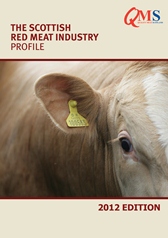THE contribution of the Scottish red meat industry to the economy of Scotland in 2011 rose to a record £2.1 billion, according to the Scottish Red Meat Industry Profile launched today (June 18th 2012) by Quality Meat Scotland.
Says a spokesperson: “The Scottish Red Meat Industry Profile reveals a ten per cent increase, year-on-year, in the contribution the farming and processing of red meat makes to the nation’s economic output.
“The £2.1 billion figure excludes subsidy payments and further processing, with the rearing of beef cattle, sheep and pigs and the primary processing sector responsible for the direct employment of 27,000 people.
“However, 2011 was a varied year for the Scottish red meat supply chain which saw beef and lamb producers benefit from stronger prices but pig farmers saw production costs rise more than their returns. Processors also felt increased pressure on their margins.”
Said Stuart Ashworth, head of Economics Services, QMS: “Tight supplies globally led to strong livestock prices during 2011 and this generated increased confidence in the cattle and sheep sectors. However, this confidence failed to materialise into greater stock numbers as producers took high prices as an incentive to cull their least productive breeding animals,”
“The Scottish suckler herd decreased for the first time since 2008. In 2011 it was 2.5 per cent smaller than in 2010 at 522,000 head. The breeding ewe flock decreased at a slightly slower pace of 1.7 per cent falling to less than 2.8 million head.”
Mr Ashworth predicted it may be another year before increased confidence is reflected in increased breeding stock populations. And, he said, there was further consolidation in the pig sector in 2011 where, although prices improved over 2010 they still averaged below 2009 levels and input costs remained high.
“The sow herd contracted sharply and returned to its downward trend of the past decade, declining by nearly 14 per cent to 32,200 head.
“In the throes of a weak economy generally the processing sector struggled to pass on the increased cost of sourcing livestock. While strong demand for beef and pork facilitated an upwards movement in retail prices during the summer months, consumption fell back towards the end of the year as prices were perceived by many consumers to have reached prohibitive levels.
“For lamb this was true for much of the year as it had already become an expensive protein and so further price increases stifled consumption. Indeed lamb retail prices grew 21 per cent, year-on-year, having already been viewed expensive relative to other proteins,
“While processors were shielded to some extent by strong overseas demand, helped by a weaker Sterling exchange rate fuelling the export trade, many felt increased pressure on margins, particularly as costs such as energy and distribution rose.”
Overall, Mr Ashworth reflected that 2011 saw beef and sheep farmers end the year with more confidence about their future than for several years, pig producers and the processing sector were more cautious.
“However, on the upside, the export trade was buoyant and presented some new opportunities to achieve improved carcase balance, while input costs began to ease towards the end of the year.”
ENDS
MEDIA RELEASE posted by Quality Meat Scotland. You too can post media releases (aka press releases) on allmediascotland.com. For more information, email here.
Contact: Doreen Graham
Phone: 0131 472 4046
Email: dgraham@qmscotland.co.uk
Website: http://www.qmscotland.co.uk






